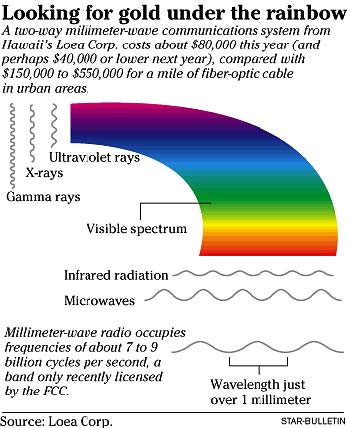News Articles
 |
June 13, 2005
Beam Speeds Wireless
Technology developed in Hawaii opens new possibilities in carrying
data short distances
By Jim Borg [email protected]
A radio beam developed in Hawaii stands to revolutionize high-speed wireless transmissions over short distances, with huge implications for the military, civil defense and fire fighting. Already, it has been adopted by the Coast Guard and the University of Hawaii Institute of Marine Biology for communications to Sand Island and Coconut Island, respectively. And it promises new possibilities for emergency response, battlefield command and control, and communications for islands, ships, aircraft and offshore oil rigs.
Known as advanced millimeter-wave radio, the information beam was developed by Loea Corp., a subsidiary of Trex Enterprises now run by retired Adm. Thomas Fargo, former commander of U.S. Pacific forces. The beam carries information between two points much like a laser, but without the problems lasers encounter with clouds, rain, fog, smog, vog, smoke, sandstorms, explosive debris and other atmospheric clutter. And at one-tenth the cost of fiber-optic cable, it is practical in places where cables are not, says Fargo, Loea chairman.
"There are two fundamental pieces that are important, and one is the ability to move really high amounts of information to connect places where it does not make sense to run fiber," Fargo said Friday in a telephone interview from Shanghai, where he was on a trade mission with Gov. Linda Lingle.
"The second one is the military application. The military is very expeditionary today, and we're going to move into places and move out, and in a lot of cases it doesn't make sense to lay fiber or set up a significant infrastructure. And the demand for information is really high right down to the smallest units, so I'm hoping Loea can help solve those problems."
 |
The technology is so new that it was approved only last year for conditional commercial use by the Federal Communications Commission. The final FCC permit is due to be issued on June 24, said Dan Scharre, Loea president and chief executive. The first generation of Loea commercial transceivers send and receive data at a rate of 1.25 gigabits per second at distances of up to 1.75 kilometers, or almost 1.1 miles. That is enough to carry 50 or 60 television channels.
The Hawaii Institute of Marine Biology, on Coconut Island in Kaneohe Bay, is using a Loea radio to communicate to the UH-Manoa campus through a transceiver at Windward Community College. "We once could make a cup of coffee before we finished downloading a document," said Jo-Ann Leong, institute director, in a letter to Loea. "We are now able to achieve connection speeds that make distance education a viable opportunity out here, and high-speed computing connectivity with the Manoa main campus computers and the Maui super computing system is now a reality."
The Coast Guard has two redundant lines for communications between its District 14 headquarters in the federal building and operations across Honolulu Harbor. "It's basically a large data pipe, a virtual pipe, that carries all types of communications," said Cmdr. Chris Meade. In an interview Friday, Meade and fellow communications officer Cmdr. Marc Sanders said the Loea system will be employed in a post-9/11 initiative to coordinate emergency communications between the Coast Guard and other government agencies, including the Department of Justice, Navy, Civil Defense, Honolulu Police and Fire departments and the Federal Fire Department.
Formed in May 2001, Loea was built on parent-company research spun off from 1990s contracts with the Pentagon's Ballistic Missile Defense Organization, now the Missile Defense Agency. An early goal was to set up laser communications between Haleakala and the high-technology research park in Kihei. But lasers -- sometimes called "free-space optics" to differentiate them from fiber optics, in which light travels in a cable -- work best in clear weather.
Frequent clouds around the 10,023-foot-high Haleakala summit made lasers impractical because the beams are easily scattered by atmospheric water vapor, much as a cloud splits the sun's reflection into a rainbow. So Trex scientists explored a new area of the electromagnetic spectrum. What they found, they hope, is a pot o' gold.
Millimeter-wave radio occupies bandwidths shorter than shortwave radio but longer than microwaves and infrared waves, the signature of heat. "In December 2001 we set up a 1-gigabit-per-second link from the rooftop of the Maui research and technology center up to a radio tower on Haleakala, 10 miles as the crow flies," recalls John Lovberg, chief technology officer for Loea. "Laser technology would not have been able to do the link, but millimeter-wave radio was able to do the link at the same data rate. We then went to the FCC and asked for the spectrum to do this commercially."
The FCC, after its usual public-comment process, approved in January 2004 the bandwidths of 71 to 76 gigahertz and 81 to 86 gigahertz, one used for transmitting and the other for receiving. Those parameters will be fully met in the second-generation Loea 2500 commercial radio, currently undergoing final testing, said Scharre.
"The whole driver for this technology is the fact that if you look at private enterprises or government or educational customers that need high-speed access, only a fraction of those are sitting on a fiber network," he said. "This is a way to solve that last-mile bottleneck problem. Most customers who need it are within a mile or two of fiber, but they are not sitting on it. So I don't see a vertical takeoff in the market, but over the years I see a very large market, and we are the first guys out there.
"Loea's success is noted in the just-out summer issue of the Missile Defense Agency newsletter. While the original focus of the research was improving airborne and satellite communications, possible future uses include real-time airborne surveillance, the newsletter says. With Loea technology, for instance, a reconnaissance plane or helicopter could download its data immediately to ground crews fighting a brush fire.